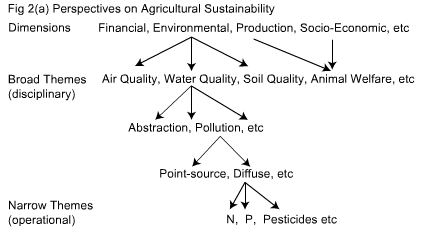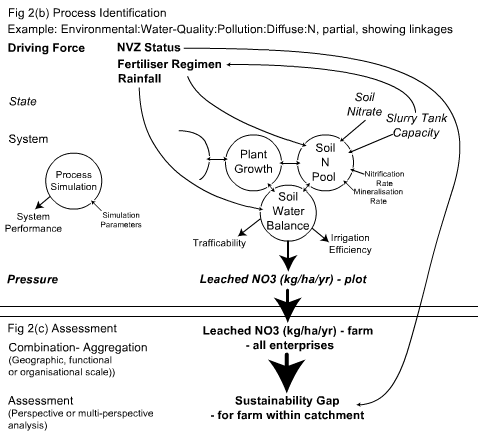Methodology and approach
The project will develop a sustainability assessment framework to bring together the burgeoning iterature on sustainable agriculture with current policymaker and stakeholder perspectives. This ill focus selection of key process and models for the integrated modelling framework.
1. Sustainability assessment framework (SAF): The development of the SAF will take place through literature review, interviews with policymakers and key stakeholders. The key methodological stages are:
- Framework development: Review sustainable agriculture literature linking commonly used assessment methods to sustainability theory (e.g. weak/strong sustainability) to develop a broad SAF ;
- Mapping of perspectives and prioritisation of issues: Interviews/meetings with policymakers and key stakeholders to characterise, map and classify alternative policy perspectives within the framework. This process will also identify associated themes and priority issues of concern (Fig 2a);

- Assessment selection and
- Benchmarking: There are a great many alternative sustainability assessment methods. Interviews will be used to identify those methods of interest to policymakers and stakeholders, along with benchmarking criteria for method evaluation;
- Assessment method selection: Drawing on the benchmarking criteria, alternative sustainability assessment methods representing each of the key sustainability perspectives will be evaluated. These methods will be applied in main project.
- Indicator and assessment classification: A range of individual indicators will support each assessment method (e.g. Fig 2b). A suitable indicator classification, such as the widely used Driving force-Pressure-State-System-Impact and Response model (Fig 2b), will give structure to the SAF.

2. Integrated modelling framework: The development of the integrated modelling framework will be undertaken using literature review, interviews and meetings with domain experts. It will identify the key biophysical processes and their interactions, and the appropriate sophistication of modelling required. The key stages are:
- Theme selection: This process will map the issues identified by policy makers (WP1) onto narrow themes to be included in the modelling framework;
- Process identification: Identification of the bio-physical and production systems processes to be modelled within the integrated modelling framework for selected themes (Figure 2b), recognising that several themes may depend on common key processes and data sources;
- Benchmarking: Benchmarking of process simulation models will draw on existing literature and meta-data sources and from direct contact with researchers. Criteria will include: (a) ability to accurately represent process across a range of agricultural contexts; (b) systems compatibility (particularly between bio-physical and production systems models); (c) ability to produce indicators to support selected assessment methods (see 1(vi));
- Combination-aggregation: Identification of linkages to larger geographic, or higher functional and organizational scales where necessary for sustainability assessment (Fig 2c);
- Identification of key datasets needed to drive use of the framework.
- Review and feedback: The development of the sustainability assessment and integrated modelling frameworks will be subject to an ongoing process of review by selected stakeholders and domain experts to ensure policy relevance and scientific integrity.
References
- Clayton, M. and Radcliffe, N. (1996) Sustainability: a systems approach. Earthscan: London.
- Department of the Environment, Transport and the Regions (1999). Strategy for Sustainable Development A better Quality of Life. London: HMSO.
- Hill, G.W. (2001) Measuring farm-level sustainability: an integrated environmental and economic accounting approach in Scottish Agriculture, PhD Thesis, University of Aberdeen.
- Hutchins, M. G., Anthony, S. G., Hodgkinson, R. A. & Withers, P. J. A., 2002. Hydrology and Earth System Sciences, 6, 1017-1030.
- Matthews, K.B., Buchan, K., Sibbald, A.R. and Craw, S. (2002). Using soft-systems methods to evaluate the outputs from multi-objective land use planning tools. IEMSs 2002 Special Sessions - 3rd Int Conf on Multiple Objective Decision Support Systems for Land, Water, and Environmental Management, Switz.
- Matthews, K.B., Sibbald, A.R. and Craw, S. (1999). Implementation of a spatial decision support system for rural land use planning: integrating GIS and environmental models with search and optimisation algorithms. Computers and Electronics in Agriculture, 23, 9-26.
- Ministry of Agriculture Fisheries and Food (2000). Towards Sustainable Agriculture: A pilot set of indicators, London: MAFF Publications.
- Organisation for Economic Co-operation and Development. (1998). Towards Sustainable Development: Environmental Indicators, Paris: OECD Publications.
- O'Riordan, T. (1988). The Politics of Sustainability, In: Sustainable Environmental Management: Principles and Practice (ed. R.Turner), Belhaven Press: Colorado.
- Scottish Executive Rural Affairs Department (2000). A Forward Strategy for Scottish Agriculture. Edinburgh: Scottish Executive.
- Smit, B. and Smithers, J. (1993). Canadian Journal of Regional Science, 16(3), 499-524.
- Smith, C.S. and McDonald, G.T., (1998), Journal of Environmental Management, 52, 15-37.


